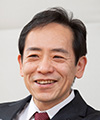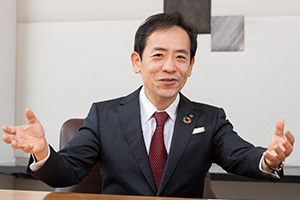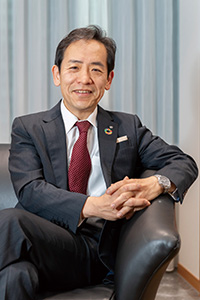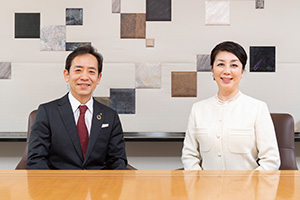 |
|||||
|
|
|||||
|
View from the Top Vol. 19, No. 2, pp. 1–6, Feb. 2021. https://doi.org/10.53829/ntr202102tp1
Our Can-do Attitude Can Make the World a Better Place. Let’s Open Up the Future by Believing in OurselvesOverviewTo solve social problems, it is important to promote digital transformation using information and communication technology. The efforts of the NTT Group to solve such problems have been highly evaluated both in Japan and overseas, e.g., being selected as a “Derwent Top 100 Global Innovator” for nine consecutive years. We asked Naoki Shibutani, a senior executive vice president of NTT, about his current duties and the required attitude of the senior management regarding the ability of their employees to solving social problems in the world that has changed significantly due to the novel coronavirus pandemic. Keywords: IOWN, technological development, remote work The key to advanced technological development is “continuation”—You were appointed a senior executive vice president of NTT in June 2020. Can you tell us about your current duties? I went from being a member of senior management of an NTT operating company to now in a position of overseeing the entire NTT Group. I am carrying out my duties with the knowledge of the significant responsibility of my new role. The NTT Group is heralding a concept called the Innovative Optical and Wireless Network (IOWN), which we are aiming to implement by 2030. Many companies from all over the world participated in the IOWN Global Forum for developing and popularizing IOWN. Starting with formulating a roadmap for the next 10 years in cooperation with member companies, we are heading step by step toward deployment of IOWN. With regard to our “Environment and Energy Vision: Zero Environmental Impact” formulated in March 2020 as an initiative of the “Promotion of ESG*1 management” (a pillar of our medium-term management strategy “Your Value Partner 2025”), “achieving extremely low power consumption” through IOWN is the main goal, and I believe that IOWN will bring about innovation not only in information and communication technology but in all fields. To carry out such a forward-looking initiative, I think it is important to not only look at the current situation and make decisions accordingly but also continue research and development (R&D) from a medium- to long-term perspective because the people involved in projects, the environment, and society may change over time.
—From what experience did such thinking originate? I learned a lesson from my experience 20 years ago of being involved in global expansion of the R&D of arrayed waveguide grating (AWG) devices. At that time, an AWG device was highly regarded as the key device in the early days of the Internet because they could multiplex multiple wavelengths with a single optical fiber, greatly increasing transmission capacity of optical networks. After achieving world-leading research results, NTT laboratories have continued to refine optical microfabrication technology (e.g., planar lightwave circuits, silicon photonics, nanophotonics) and succeeded in evolving it into the key technology of IOWN, namely, photonics-electronics convergence. NTT laboratories have evolved this technology and continued to carry out cutting-edge research for more than 20 years, and I think that “continuation” is an important part of advanced technological development. I believe that even if the person in charge changes, we must keep the technology pipeline flowing, and technological development from a long-term perspective that is not affected by the ups and downs of corporate management will produce outstanding results. Efforts to constantly circulate our products on the market are also important. In particular, it is necessary to build a so-called “ecosystem” in which our R&D results are commercialized, made profitable, and used to fund future R&D. Through open innovation with other leading companies and universities, I would like to build such an ecosystem that inherits and spreads technologies both vertically and horizontally. For many years, I’ve been involved in reliability design for the digitization of switches while pursuing the construction of safe, low-cost, and efficient networks. After gaining such experience, in the early 2000s, our optical broadband and “Hikari Denwa” optical Internet Protocol (IP) telephone services became widespread. In line with that trend, areas with Internet connection rapidly expanded without sufficient reliability design and performance evaluation. Therefore, many communication failures occurred on a nationwide scale in 2007, which resulted in a crisis that shook the foundation of NTT. At that time, IP networks were cheap and flexible but involved immature methods for achieving redundancy and recovery. On top of that, the reliability of the network architecture was not fully considered because the priority was to expand services quickly, and most operations (including design, construction, and maintenance) were outsourced. I thought that the state of affairs in which NTT could not even investigate the causes of failures and consider recovery measures led to the continuation of those large-scale failures. Given the situation I described above, with the help of NTT laboratories, we started studying the Next Generation Network (NGN), namely, the next-generation IP integrated network, from scratch, and we worked on insourcing on-site operations (such as design, construction, and maintenance) that had been outsourced. From these efforts, we developed this NGN in two years and introduced it nationwide. Since then, the NGN has expanded to serve more than twenty-million customers over more than 10 years without facing any major failures. We have now achieved 100% insourcing of daily operations of the NGN. From this experience, as a technology-strategy manager, I was convinced that, first, our core technology should not be simply outsourced and, second, reliability design should be given top priority no matter what. I believe that to further transform NTT into a digital company, we should give top priority to strengthening our capability by insourcing operations such as designing artificial intelligence (AI) analytical models, analyzing digital data, investigating network architectures that are resilient against cyberattacks, and implementing countermeasures against unauthorized access. However, the shortage of engineers in these technical fields is a serious problem common to all NTT Group companies. Accordingly, I want to accelerate the training of more engineers in the fields of AI, digital transformation, and cybersecurity.
Accumulate successful experiences with the “stretch method”—You can learn from anything and use it in your work. In a previous interview, I talked about working hard to restore equipment and support customers in the wake of the Great East Japan Earthquake as the manager of the Fukushima branch. The actual conditions of our equipment affected by the disaster were not what was expected at the head office. I learned the importance of confirming the locations, settings, and state of equipment at the actual site such as what equipment is installed in potentially submerged areas near the coast as well as in areas with a risk of landslides and bridge collapses. After witnessing the damaged equipment, I regretted that if I had confirmed the sites in advance on the basis of the knowledge that I acquired through being in charge of reliability design, we might have been able to minimize the damage. Ever since that disaster, I now ask our employees to confirm the actual location, setting, and state of equipment no matter how difficult it is. This confirmation—which I call in-field practical ability—should be handed down from generation to generation. I think this way of thinking applies to not only equipment sites but also sales sites. For example, if you want to do a job related to agriculture, you should go to a farm and learn farming; in other words, it is vital to understand issues from the same perspective as the customer. If we can use our experiences acquired through our five senses in our own specialized field, we will be able to make more realistic proposals. It is important to face the issues of our customers as if we were them and solve problems while keeping pace with them. As a person in charge of technology strategy, I also think that companies that bring innovation to society develop technologies and improve them to be used in the real world. Companies that can achieve this can be said to be “technology driven.” This is important for NTT as well. Now that we can no longer compete in communication alone, it is time to change the culture of the entire NTT Group. When I took my current position in June 2020, I thought I wanted to see the upper limits of our impact on changing the world when the potential of the NTT Group is freely unleashed. Although NTT is a private company, it has a public element in light of our background, and it is unique in the sense that it is engaged in basic research while being a telecommunications carrier. I think that our technical and social-contribution capabilities are better than our employees can imagine; however, to be honest, I don’t think we have fully used these capabilities. To overcome this problem, I ask our employees and related parties to perform difficult tasks when they try to solve various problems. Although those who are asked to do so seem surprised at first, as they are repeatedly asked to do such tasks, they feel more confident in their ability to solve problems and seem to find it interesting to take on the challenge. If you do what you can to the extent you can, cultural change is unlikely to occur, and your frame of mind will be hard to change. However, our employees can accumulate valuable experiences with the support of their supervisors in expanding their limits and helping them overcome hurdles. By repeating this process, your confidence what you can do will grow, and cultural change will happen.
—It is important for employees to be aware of their advanced abilities and for senior management to draw out their strengths. I’m working on solving problems with the “stretch method” to gradually expand employees’ limits. If you don’t understand a person’s limits, namely, a standard, you can’t expand it or set a definite goal. On the other hand, I sometimes think it’s better not to set limits at all. I say that because when adapting to changes, the limits also change according to the criteria of those limits. For example, NTT has always been particular about the quality of our services and products, so naturally the criteria of standards are also high. If the standards are met, the services can be used safely and securely; however, if we become fixated with those criteria, costs and price will increase, and the time it takes to provide services may become excessive. However, a global trend is to launch products and services even if their functions are somewhat insufficient and improve them while they are being used. This means launching products onto the market at prototype level and polishing them up while they are on the market. In fact, young employees at NTT EAST stood up thinking that they could make social contributions during the coronavirus pandemic by using their skills. In particular, they created and launched a remote desktop service for teleworking with new security technology in just two weeks without spending money. Although we did not guarantee the quality of service, when we provided it free of charge, it became a big hit without any trouble. Since then, we have continued to improve its security and operational functions while responding to user requests. If these young people have a place where they can take on challenges, their ideas can be put to good use and cultural change will happen. I want to review everything from the perspective of critical thinking by asking “Is this really right?” rather than continuing to protect matters like golden rules. Safety and security are important; however, I want to create an environment in which anyone can casually try something new without hesitation. Do you know the saying “The sky is the limit”? That is the title of a book I read when I started working. It means “the possibilities are as infinite as the sky.” I think it is probably us who impose limits on ourselves. Shortly after I joined NTT in 1985, the Japanese economy slumped as the economic bubble burst. I don’t want to make the excuse that in addition to the “lost” 20 years due to that economic slump, another 10 years will be lost due to the novel coronavirus pandemic. I doubt the people who worked hard would say the word “lost” in regard to the results of doing their best. Action starts from the heart, not the mind. This is why I think that having the spirit of “Let’s try” is required for those in senior management. When an employee proposes a plan or project, his/her supervisors sometimes point out the issues of the proposal in view of their own experience only. In response to such attitudes of supervisors, employees hesitate to move ahead because they think all those issues must be solved before they can move forward, so I ask supervisors to hold back and say “That’s a good idea!” first. Expressing your solid support and talking about how to improve, and sharing the lessons you have learned will motivate your employees. If you kill your employees’ enthusiasm, they will never come to you with proposals, and in the long run, that situation will be a loss to the company and society as a whole. I have continued my “That’s a good idea!” activities from my days at NTT EAST even after coming to NTT. Even now, I hang on the office wall the three slogans “That’s a good idea!”, “Overcoming barriers,” and “Making an impact” and continue to ask employees to put them into practice on a daily basis.
Be transparent regarding problems and develop an attitude of solving them in good faith—What are the qualities and perspectives required of senior managers of a group with 300,000 employees worldwide? First, I realized that it is necessary for me to think with a longer time frame and extend my areas of expertise. I think senior managers are required to look at the world 30 years from now from a global perspective, aim to make an impact on the future, focus on what to do to make it happen, and present a roadmap to that future. I think the concept of IOWN that President Sawada advocated is an easy-to-understand example. The senior management has roles to play. The vice president devises the tactics to materialize the president’s strategy and works with the senior management of group companies to execute those tactics. On the basis of those tactics, other senior managers convey enthusiasm and worthiness to 300,000 employees. I think that such steady activities are vital. Furthermore, as the management theory organizational ambidexterity suggests, unless you are a company that can start new businesses while maintaining existing ones, at best, you will have no future. In reality, however, the more you visit the sites of your existing businesses, the more you stick to those businesses. Perhaps many senior managers often hear on-site that “We don’t have the budget,” “We can’t provide more people,” or “If we want to make a profit, we can only do this.” To develop a future-oriented business even under such circumstances, it is necessary for employees to share convincing stories, understand and be motivated by them, and take the challenge of exploration. In addition, it’s very important for the senior management to deliver a message that resonates with universal values when presenting our guidelines to the 300,000 employees. Although building a relationship of trust with our employees is very difficult, it can be lost in a moment. I think that the senior management must be transparent regarding problems with all employees and customers and continue to take actions and make statements to cultivate an attitude of solving such problems in good faith.
—Please say a few words to researchers and engineers inside and outside the company. I’ll say to them “The game is long.” Thirty years ago, I was greatly inspired by the free society of the United States that I witnessed while studying there. After returning to Japan, I established a remote work environment using ISDN*2 data communication and worked on Japan’s first experiments on satellite offices. With a budget of 500 million yen, we set up satellite offices in Funabashi (Chiba Prefecture), Ageo (Saitama Prefecture), and Kamakura (Kanagawa Prefecture), and a “resort office” in the Yatsugatake mountains (Nagano Prefecture). At that time, the communication tools we had were telephones, fax machines, data transfer by floppy disks, and fixed-point cameras, and institutional aspects, such as communication rules and performance management, were inadequate. Unfortunately, this work style could not be widely popularized. However, through this experience, making people’s work style freer and more creative became one of my life’s work. More and more people are using remote tools due to the novel coronavirus pandemic, and Japanese companies are seriously considering reforming their employment systems. Throughout my 30-year mission, I learned that social change is not just about technology; it takes a long time, and it is important not to give up. I hope that all researchers/engineers will continue to have enthusiasm without forgetting the thoughts they had when they first joined the company. By doing that, they will change the world. I believe that the accumulation of daily simple and steady steps with intent will lead to global expansion of IOWN to support the digital society and creation of a sustainable society based on renewable energy. Achieving these goals will face many barriers and take a long time; nevertheless, society can be changed for the better, and we have the power to do it. Therefore, believe in yourself, and let’s move forward step by step.
Interviewee profileCareer highlightsNaoki Shibutani joined Nippon Telegraph and Telephone Corporation in 1985. He worked in NTT Department I, where he engaged in operations targeting corporations beginning in 1999 then served as a senior manager of the Planning Department at NTT EAST starting in 2001 (and was a guest researcher at the Center for Strategic and International Studies (CSIS), Washington, D.C.). In his career at NTT EAST, he also served as the department manager of the Plant Planning Department, Plant Section, Network Business Headquarters; manager of the Fukushima branch office; executive manager of the Medium-term Management Strategies Promotion Office of the Corporate Strategy Planning Department; senior vice president and executive manager of the Plant Planning Department, Network Business Headquarters; senior vice president and executive manager of the Tokyo Olympic & Paralympic Games Promotion Office; and senior executive vice president and senior executive manager of the New Business Development Headquarters, president & chief executive officer of NTT Vietnam Corporation, senior executive manager of the Digital Transformation Headquarters, and president & chief executive officer of NTT e-Sports Corporation. He assumed his present position in June 2020. |
|||||






